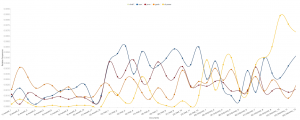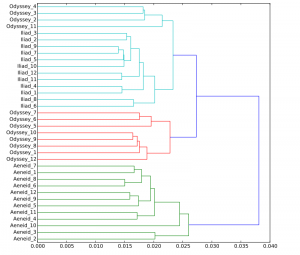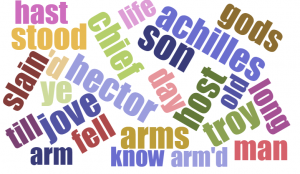My project has evolved a lot since I started this semester. There were a lot of ups and downs, and switching of ideas, but I finally settled on a research question. Well let me be more accurate, I settled on two research questions: Can it be said that the Aeneid is stylistically based on the Odyssey and the Aeneid? And: Can it be said that the Aeneid is based on the Odyssey and the Iliad in terms of plot? Someone viewing these questions from the outside may say that these questions ask the same thing. I would challenge them to think deeper than that. The interesting part of these questions is that they do not ask the same thing twice. Style and plot are two very different sides of the story, and being able to use the tools at my disposal for digital text analysis allowed me to see that clearly.
My corpus consists of three books, each split evenly into 12 parts. This would allow any programs I used to accurately read each section, as well as be able to accurately analyze each. We ran into several problems where works that were too big would not work with our software, so this step allowed me to bypass that even though my entire corpus contains over three hundred thousand words. The books I chose to use were the Iliad, the Odyssey, and the Aeneid. The Aeneid is a story of Aeneas and his travels, leading to the foundation of what later became Rome. It essentially served as a foundation myth for Rome. The Odyssey is the story of Odysseus and the trials and tribulations he went through on his return home after the Trojan War. The Iliad is a story of war. It follows Achilles and his efforts in the Trojan war. It acts as a prequel of sorts to the Odyssey, as a lot of the characters are carried over between books.
The platforms that I chose to use for my research were Voyant and Lexos. Both of these platforms gave me windows into the answers of my questions. I mainly used Voyant to analyze plot while I used Lexos to analyze style. However, that is not to say that I couldn’t use either to do the other.
One of the most important things that I gathered from Voyant was this image:
From this I can see that each book follows a trend of the antagonist(s) being one of the most mentioned words in the corpora. This is expected because this is what drives the protagonist to keep moving forward in their travels. This explains why the plot may be similar between each of the books. If they follow similar tracts it is likely that Virgil took inspiration from Homer. Another important image I got from Voyant was this:
This graph shows me that there are common themes between all of the books. The most common words of the entire corpus are shown in this graph. Ulysses (Odysseus) appears in all three books. This shows that Vergil pulled the character from Homer. In addition, they all use the gods in their respective works. This graph shows that the style of the writers is very similar because they use many of the same words to express their thoughts.
The other platform I used was Lexos. Lexos helped me mainly to look at style within my corpus. The first thing I got from Lexos was a dendragram. Dendragrams are used to show how closely related pieces of writing are through the use of zeta lists and word frequencies. In making this dendragram, I used the culling options to use the top 100 most frequent words. I also left stop words in to see if that would affect the writing style of the various authors. This Is the dendragram that I received:
As you can see the graph shows that the Odyssey and the Iliad are very closely related but the Aeneid is removed a bit. I do not think that this shows that the Aeneid is completely separate from the other two but that there are some stylistic differences. Those differences may come from the tranlslators, and until I find a translator that translated all three there is now way to know if that is the case or not. What is interesting to look at however, is that four books of the Odyssey are very closely related to the Iliad. What is even more interesting is that those are the books that are most like the odyssey in plot, so Lexos is definitely picking up on somethings even with the wall of having different translators.
The next thing that I used Lexos for was word clouds. Here are a few examples of word clouds that I used:
All three of these show me, what words teach of the books share leading to me being able to understand more about the style of each work.
In the end I affirmed what my training in the classical arts has lead me to believe all along. The Aeneid is definitely based on the Iliad on the Odyssey. Though the connections are loose, there is a connection there so I feel confident saying that both stylistically and in terms of plot, the Aeneid draws from the contexts of these two books that came before it. It may have been used for a different purpose but I feel comfortable saying that, different purpose or not Homer influenced Vergil in his writing.
Bibliography
Aeneid Translation by: Dryden, John, 1631-1700
Iliad Translation by: Cowper, William, 1731-1800
Odyssey Translation by: Butcher, S. H. (Samuel Henry), 1850-1910, Lang, Andrew, 1844-1912





